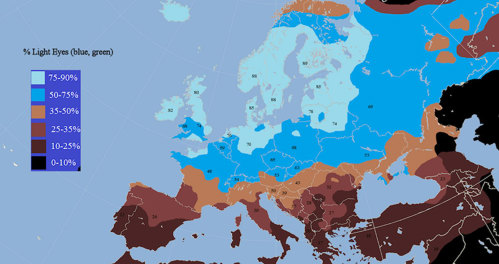
Is everyone with blue eyes related? How was that trait passed on?
August 9, 2013

- Related Topics:
- Eye color,
- Human evolution,
- Pigmentation traits
An undergraduate from California asks:
Surprisingly, it does appear that most Europeans with blue eyes are pretty closely related. Scientists can tell this by looking at their DNA.
One piece of evidence is that most blue eyed Europeans share the exact same DNA difference that causes their blue eyes. Given that there are lots of ways to get blue eyes, this suggests that the people who share this DNA difference all came from the same original ancestor (or founder). By studying the DNA in a bit more detail, scientists have concluded that this original blue-eyed ancestor probably lived around 6,000-10,000 years ago.1
It is important to note here that not everyone with the same trait is necessarily so closely related. For example, red-haired Europeans get their red hair from a variety of DNA differences. Not all redheads can trace their history back to an original red-haired ancestor.
Now the fact that blue eyes appeared out of nowhere isn’t that weird … our DNA is much less stable than a lot of people think. Changes in DNA (called mutations) happen all the time, so it isn’t surprising that occasionally one will happen in just the right place to cause blue eyes. This probably happened a number of times throughout human history.
No, the weird part is that the blue eye mutation from that original ancestor took hold and spread throughout Europe. Usually this means that the mutation had an advantage. If it didn’t, then like most neutral mutations, it would stay at some low level or disappear entirely. But it is obviously still around and going strong.
You may have noted that I said that mutations “usually” spread because of an advantage. The reason I had to add that qualifier is that sometimes a trait spreads in a population for different reasons, often having to do with luck.
Imagine a mutation that leads to blue eyes appearing in an ancestor. The blue eyes freak out everyone in the village so this person is banished to an island, along with anyone else who might weird out the villagers.
Now something happens and everyone in the world is wiped out except the people on the island. Blue eyes will have gone from very rare to very common. And as these islanders repopulate the world, blue eyes will stay common. This kind of thing is more common than you might think and there are many examples of this sort of “founder effect.”
And this isn’t the only way that chance might increase a trait. Click here to learn about a few others.
While these are possible for other traits, it doesn’t look like this is what is going on for blue eyes. By looking at the DNA around the blue eye mutation, scientists can see that blue eyes have been strongly selected for. In other words, they had some sort of evolutionary advantage. (This is another piece of evidence that blue eyes came from a single common ancestor.)
Now the tricky part is figuring out what that advantage is. Scientists have considered a couple of possibilities (none of which has been proven).
One is that blue eyes were attractive to potential mating partners. And the other is that blue eyes themselves weren’t that useful for the Europeans. Instead, they are a side effect of something that was — lighter skin.
Peacock Feathers and Blue Eyes
In nature, individuals with the best traits go on to have more children than those without those traits. The children who end up with these traits then go on to have more children and so on. After a while, more people have these traits.
This is one of the major ways that certain gene versions like blue eyes can spread through a population. Blue-eyed people have more kids and their blue-eyed kids have more kids. As blue eyes spread, so does the gene.
Usually when we think about an advantage of a trait, we think about something that makes an individual survive better. But not all advantages are based on survivability.
Remember that the key to a trait becoming more common over time is that those with the trait have more kids. Being a better survivor is one way to accomplish this. But another way is being attractive to potential mates.
If you are more attractive to the opposite sex, chances are you’ll attract more mates. This is called “sexual selection,” and may be why blue eyes spread so rapidly.

It may be that the people who spread across Europe thousands of years ago found blue eyes attractive. The blue-eyed humans had lots of partners, and subsequently had many children (who all had at least one copy of the blue-eye color gene).
This is a fun theory, but we really don’t have any proof that it’s true. We can’t go back in time and ask these folks if they preferred blue eyes to brown. This might be why blue eyes spread, but we may never have a way of proving it.
Light Skin Advantage with Bonus Blue Eyes
Another possibility is that blue eyes didn’t spread because they had any advantage. Instead they spread because they were a side effect of something that was an advantage — light skin.
Back before fortified milk and vitamin supplements, we got most of our vitamin D from the sun. In most parts of the world, sunlight is strong and frequent enough that people can get plenty of it even with dark skin. In fact, given the dangers of the UV light from the sun, dark skin is an advantage in these sunny places.
But then a few humans moved to Europe with its short, cold winter days. They had to cover up to keep warm and the sun was hardly out much. The end result was that with dark skin, they probably could not get enough vitamin D.
There were a few lucky individuals who had the lighter skin they needed to get their vitamin D way up in the north. They survived better and had more kids. Over time, fair skin became very common in northern Europeans.
One idea is that blue eyes and fair skin sometimes come from the same piece of DNA. If this were the case, then blue eyes would just be a trait that hitchhiked along with the more useful light skin.

This is another good theory but so far scientists haven't been able to prove it. The DNA difference that is the most common cause of blue eyes does make skin lighter but it isn’t the major reason some Europeans have such pale skin.
So right now we don’t know why blue eyes spread so far and wide across Europe. We have some good ideas, but no proof yet. And it may remain a mystery for a very long time.

Author: Dr. D. Barry Starr
Barry served as The Tech Geneticist from 2002-2018. He founded Ask-a-Geneticist, answered thousands of questions submitted by people from all around the world, and oversaw and edited all articles published during his tenure. AAG is part of the Stanford at The Tech program, which brings Stanford scientists to The Tech to answer questions for this site, as well as to run science activities with visitors at The Tech Interactive in downtown San Jose.
 Skip Navigation
Skip Navigation
